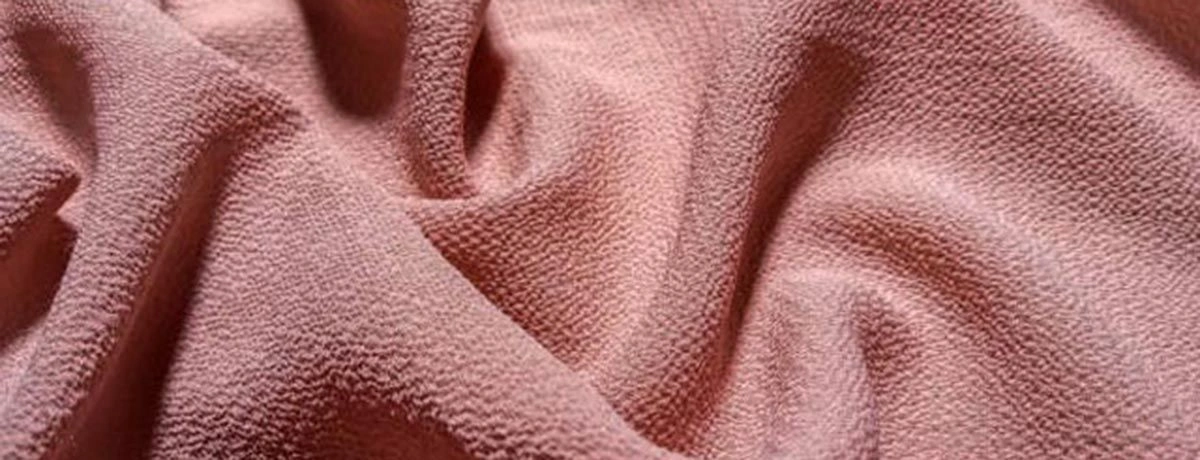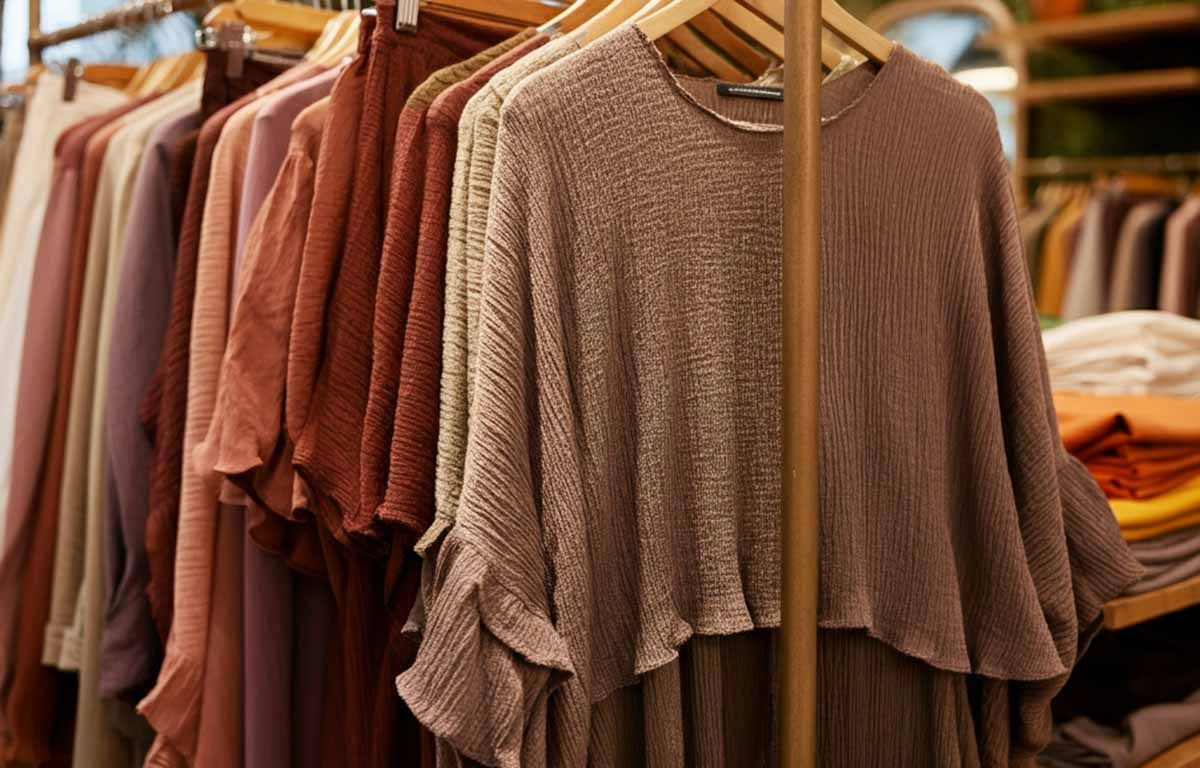Crepe Materials for Textile Professionals

Crepe materials have become a staple in the textile industry, loved for their unique textures, versatility, and numerous applications. Whether you’re a garment manufacturer or a textile trader, understanding the qualities and applications of crepe fabric is essential for staying competitive in today’s market.
This guide explores the key features of crepe materials, their composition, manufacturing process, types, applications, and care tips. You’ll also discover emerging trends driving innovation in crepe fabrics.
What is Crepe Fabric?

Definition and History of Crepe Fabric
Crepe fabric is a type of textile renowned for its unique, rippling, three-dimensional texture. The term “crepe” is derived from the French word “crêpe,” meaning “pancake,” which reflects the fabric’s crinkled appearance. This distinctive fabric has a rich history, with its origins tracing back to ancient civilizations, including Egypt. However, it was in the 19th century that crepe fabric truly gained prominence in Europe, particularly in France. During this period, French artisans perfected the art of creating crepe, associating it with luxury and elegance. Today, crepe fabric continues to be celebrated for its sophisticated texture and versatile applications.
What Makes Crepe Materials Unique?
A Unique Crinkled Texture
One of the most defining characteristics of crepe materials is their crinkled or slightly wrinkled surface, which adds depth and dimension. This distinctive texture is created through specific weaving techniques or by using crepe yarn, which undergoes a hard-twisting technique to achieve its unique crinkled texture. The crepe cloth material’s charm lies in its versatility—it feels luxurious in high-fashion garments while maintaining practicality for everyday wear.
Variety of Fiber Types
Crepe fabric is not confined to a single type of fiber. It is crafted using both natural fibers like silk, cotton, and wool, and synthetic fibers such as polyester, rayon, and spandex. Silk blend fabrics are particularly popular for special occasion apparel, including bridal parties and dresses. The variety of fiber choices ensures that crepe adapts seamlessly to diverse applications and price points. Sustainable fabrics, including eco crepe options, are also available, emphasizing the eco-friendly impact of using natural materials like silk and wool.
Wide Range of Applications
Crepe fabric spans an impressive range of uses. From high-end fashion garments, including evening gowns and tailored suits, to home décor items like curtains and upholstery, crepe has proven its versatility across industries.
Innovative Trends
Modern crepe fabric designs are increasingly aligned with consumer demands for eco-friendliness and functionality. Innovations such as recyclable crepe fabrics and water-resistant formats are reshaping the textile industry.
The Composition of Crepe Materials
Crepe fabrics are often made by combining twisted yarns, which create irregularities in thickness and result in the characteristic crinkled texture. Depending on the type of fiber used, the composition can vary:
-
Silk Crepe Fabric: Known for its lustrous texture and lightweight elegance.
-
Cotton Crepe Fabric: Offers breathability and comfort, ideal for summertime fashions.
-
Crepe Wool Fabric: A thicker option, suited for outerwear and luxurious winter garments.
-
Crepe Fabric Polyester: Durable and wrinkle-resistant, perfect for durable, versatile clothing.
-
Crepe Rayon Fabric: Soft yet structured, offering excellent drape and comfort.
Crepe fabric is a lightweight fabric with a unique texture and crinkled surface, making it versatile for creating elegant clothing, accessories, and home textiles. It can be made from various materials such as silk, cotton, wool, or synthetic fibers.
By blending different fibers, manufacturers can offer tailored solutions based on functionality and aesthetics. Thin fabric, with its lightweight and crinkly texture, is particularly suitable for formal wear. When sewing with thin fabric, care must be taken when handling this delicate material, especially when cutting and pressing.
How Crepe Fabric is Made
-
Twisted Yarn Preparation
Crepe fabric begins with high-twist yarns. The fibers are spun and twisted tightly to introduce tension, creating the textured effect during weaving.
-
Weaving or Knitting
The yarns are woven or knitted using specialized techniques, allowing the natural crinkling to appear.
-
Finishing Processes
Treatments like heat setting or chemical washes further define the wrinkles and texture. These steps enhance durability and ensure the longevity of the fabric.
-
Dyed or Printed Final Product
Crepe fabric is often dyed or printed to create rich, vibrant colors or intricate patterns suited for specific applications.
Weaving and Knitting Techniques
The creation of crepe fabric involves specialized weaving or fabric treatment methods that produce its characteristic texture. The process begins with twisting the yarns in a specific manner to create a textured fabric. This technique can be applied to various fibers, including silk, cotton, wool, and synthetic fibers. The choice of fiber significantly influences the properties of the crepe fabric, such as its drape, texture, and durability. For instance, silk crepe offers a luxurious feel and elegant drape, while polyester crepe fabric provides durability and ease of care. The intricate weaving and knitting techniques ensure that crepe fabric maintains its unique, textured appearance.
Types of Crepe Fabric and Their Features
Silk Crepe Fabric
-
Lightweight and sheer.
-
Distinguished by its sheen and elegant drape.
-
French crepe, often used in lingerie, is known for its intricate design variations in the fashion industry.
-
Ideal for evening wear and luxury garments.
Crepe de Chine
Crepe de Chine is a distinguished type of crepe fabric made from silk. It is celebrated for its smooth finish and subtle pebbling, which contribute to its luxurious feel. This fabric drapes beautifully, making it a popular choice for formal wear, including wedding dresses and evening gowns. Crepe de Chine is also favored in high-end fashion designs due to its elegant drape and lightweight properties. Its versatility and refined appearance make it a staple in the wardrobes of those seeking sophistication and style.
Cotton Crepe Fabric
-
Soft, breathable, and durable.
-
Suitable for casual clothing and summer dresses.
Crepe Wool Fabric
-
Heavier weight with excellent insulation.
-
Wool crepe is suitable for heavy-duty clothing applications like suits, pants, and dresses due to its durability and texture.
Polyester Crepe Fabric
-
Wrinkle-resistant and easy to care for.
-
Commonly used in everyday garments and affordable options.
Crepe Rayon Fabric
-
Smooth, lightweight, and breathable.
-
Excellent for blouses, skirts, and flowing dresses.
Scuba Crepe Fabric
-
Combines the crinkled texture with stretch for added flexibility.
-
Used in body-hugging designs and modern fashion.
Crinoline Fabric
-
Stiffer crepe variant often used in petticoats and structured garments.
By understanding each type, garment manufacturers and textile traders can curate the right materials for their collections.
Characteristics of Crepe Fabrics
-
Versatility: Suitable for diverse designs, from couture gowns to casual tops.
-
Breathability (cotton and rayon-based crepes): Perfect for warm climates.
-
Durability (polyester and wool crepes): Long-lasting and low-maintenance.
-
Luxurious Appearance (silk crepe): An elevated option for upscale markets.
Main Applications of Crepe Fabric
-
Fashion Industry
Crepe is highly favored in designing flowing dresses, formal attire, scarves, and outerwear.
-
Home Décor
Used for drapes and curtains, crepe adds elegance and texture to interior spaces.
-
Event and Wedding Wear
Choice fabric for bridal gowns, evening wear, and special occasion outfits.
Garment Applications
Crepe fabric is incredibly versatile, making it suitable for a wide range of garment applications. It is particularly well-suited for formal wear, such as wedding dresses, evening gowns, and tailored suits, thanks to its elegant drape and luxurious texture. Additionally, crepe fabric is used in casual wear, including blouses, skirts, and pants. Its lightweight and breathable properties make it an excellent choice for summer clothing, providing comfort and style. Whether for high-fashion or everyday wear, crepe fabric offers a blend of elegance and practicality.
Home Decor and Craft Projects
Beyond garments, crepe fabric finds its place in home decor and craft projects. Its unique texture and elegant drape make it an excellent choice for creating beautiful home decor items, such as curtains, table runners, and wall hangings. The fabric’s versatility extends to craft projects, where it can be used to make accessories, bags, and other decorative items. Crepe fabric’s ability to add a touch of sophistication and texture to any project makes it a favorite among crafters and interior designers alike.
By understanding the diverse applications and unique qualities of crepe fabric, garment manufacturers and textile traders can make informed decisions to enhance their product offerings and meet the demands of their customers.
Care Tips for Crepe Fabric
-
Hand Washing (Recommended for delicate types like silk crepe): Use cold water and mild detergent.
-
Machine Washing (For synthetic options): Opt for a gentle cycle and use a laundry bag.
-
Avoid High Heat (For all types): Steaming is preferable to ironing to maintain the fabric's texture.
-
Dry Flat (To prevent stretching): Lay the fabric on a clean surface and avoid hanging.
Proper maintenance extends the life of crepe garments, preserving their elegance over time.
Trends in Crepe Materials
Sustainability in Crepe Production
The rise of eco-conscious consumers is driving the production of more sustainable crepe fabrics, including organic cotton crepe and recycled polyester options. Canton crepe, a distinctive crepe style from the Chinese province of Canton, is known for its unique characteristics, such as being heavier than crepe de chine due to the use of thicker crepe yarns, and remains popular in Asian-inspired garments.
Functional Crepe Designs
Advanced crepe features such as water and stain resistance, UV protection, and stretch functionality are fast gaining popularity in activewear and performance fashion.
Digital Printing on Crepe
Digital printing has opened a world of possibilities for customized patterns and intricate designs on crepe fabric, further enhancing its appeal.
Blended Crepe Fabrics
Blending fibers like silk and synthetic materials offers a unique combination of luxury and affordability.
By keeping up with these trends, manufacturers can appeal to the growing demand for innovative, responsible, and high-performing textile solutions.
Explore the Endless Possibilities of Crepe
Crepe materials remain a favorite in the textile industry, thanks to their unmatched versatility, timeless elegance, and growing eco-friendly appeal. From luxurious silk gowns to durable and wrinkle-free everyday clothing, crepe offers something for every need.
For garment manufacturers and textile traders, understanding the nuances of crepe fabric—from its composition and types to care and trends—equips you to make informed decisions and elevate your product offerings.
Whether you’re sourcing crepe cloth material, scuba crepe fabric, or silk crepe fabric, incorporating these textiles ensures you stay ahead in the competitive textile market.
Looking to source premium crepe fabrics? Reach out to explore expertly curated collections tailored for your business needs.
Resources Page
- Crepe Georgette Fabric: A Comprehensive Guide for Garment Manufacturers
- Comprehensive Guide to Georgette Polyester Fabric for Garment and Textile Professionals
- The Ultimate Guide to Crepe Knit Fabric for Garment
- Exploring Heavy Georgette Fabric: Types for Sewing
- A Comprehensive Guide to French Crepe Cloth for Garment Manufacturers
- All You Need to Know About Pure Crepe Fabric
- Top Georgette Fabric Black: Your Guide to Elegance and Versatility
- A Guide to Georgette Fabric White for Garment
- A Comprehensive Guide to Heavy Moss Crepe Fabric
- The Versatility of Printed Silk Crepe Fabric in Garment Manufacturing
